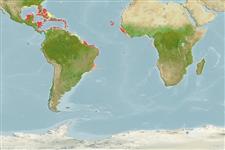>
Eupercaria/misc (Various families in series Eupercaria) >
Labridae (Wrasses)
Etymology: Doratonotus: Latin, deauratus = golden + Greek, noton = back (Ref. 45335).
More on author: Günther.
Environment: milieu / climate zone / depth range / distribution range
Écologie
marin récifal; profondeur 1 - 15 m (Ref. 9710). Tropical; 33°N - 29°S, 98°W - 10°E
Western Atlantic: Bermuda and southern Florida, USA to Brazil (Ref. 57756). Eastern Atlantic: Cape Verde Is, and São Tomé.
Taille / Poids / Âge
Maturity: Lm ? range ? - ? cm
Max length : 9.4 cm TL mâle / non sexé; (Ref. 9626); poids max. publié: 10.80 g (Ref. 9626)
Épines dorsales (Total) : 9; Rayons mous dorsaux (Total) : 10; Épines anales: 3; Rayons mous anaux: 9. Color primarily grass green; usually some scattered small white or pale blue spots on head and body; small reddish brown spot near upper edge of caudal fin and another near lower edge (Ref. 13442).
Inhabits shallow beds of turtle grass (Thalassia). Common but seldom noticed (Ref. 9710).
Life cycle and mating behavior
Maturité | Reproduction | Frai | Œufs | Fécondité | Larves
Oviparous, distinct pairing during breeding (Ref. 205).
Robins, C.R. and G.C. Ray, 1986. A field guide to Atlantic coast fishes of North America. Houghton Mifflin Company, Boston, U.S.A. 354 p. (Ref. 7251)
Statut dans la liste rouge de l'IUCN (Ref. 130435: Version 2024-1)
Menace pour l'homme
Harmless
Utilisations par l'homme
Pêcheries: commercial; Aquarium: Commercial
Outils
Articles particuliers
Télécharger en XML
Sources Internet
Estimates based on models
Preferred temperature (Ref.
123201): 26.1 - 28.2, mean 27.4 °C (based on 549 cells).
Phylogenetic diversity index (Ref.
82804): PD
50 = 1.0000 [Uniqueness, from 0.5 = low to 2.0 = high].
Bayesian length-weight: a=0.01096 (0.00647 - 0.01859), b=3.04 (2.89 - 3.19), in cm total length, based on LWR estimates for this species & (Sub)family-body (Ref.
93245).
Niveau trophique (Ref.
69278): 3.3 ±0.4 se; based on size and trophs of closest relatives
Résilience (Ref.
120179): Haut, temps minimum de doublement de population inférieur à 15 mois (Preliminary K or Fecundity.).
Fishing Vulnerability (Ref.
59153): Low vulnerability (10 of 100).
Nutrients (Ref.
124155): Calcium = 128 [74, 235] mg/100g; Iron = 0.868 [0.485, 1.651] mg/100g; Protein = 18.5 [15.6, 20.7] %; Omega3 = 0.161 [0.096, 0.267] g/100g; Selenium = 19.7 [10.8, 37.7] μg/100g; VitaminA = 163 [48, 637] μg/100g; Zinc = 2.04 [1.34, 3.22] mg/100g (wet weight);
